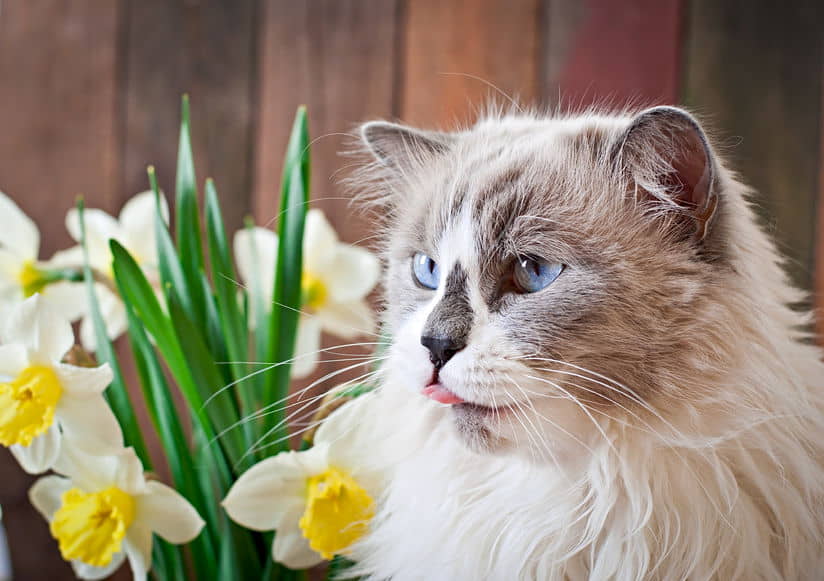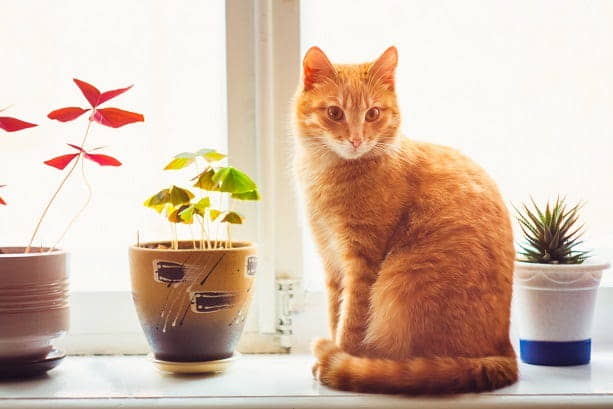Jacque Lynn Schultz, C.P.D.T., Companion Animal Programs Adviser. National Outreach
As the days grow colder and shorter, plants from window boxes and screened-in porch planters are brought inside. Tulip, an inquisitive tabby, eyes the new additions to her environment, hopping up on the coffee table to get a better view. Within moments, she is nibbling the greenery — and a short time later, she’s retching up a foamy green mess on the rug. It’s not easy to keep cats and plants in the same space, but with some inventiveness, it is possible.

The Need to Nosh
Back in the days when the feline diet was strictly self-caught, cats got their veggies predigested from the stomach contents of their prey. Today, many cats still try to supplement meat-based cat food with leafy greens. In a study by Melanie Morgan and Dr. Katharine A. Houpt of the Animal Behavior Clinic of Cornell University, 36 percent of 122 cats were found to nosh on houseplants.
This habit can prove dangerous. While not a complete list, the following plants and their relatives can cause everything from mild gastric distress to death: aloe vera, amaryllis, members of the lily family, asparagus fern, azalea, corn plant, dieffenbachia, dumb cane, many ivies, philodendron and the holiday favorites, holly and mistletoe. If you suspect ingestion and notice an abnormal breathing or heart rate, weakness, bloody diarrhea, oral ulcers, severe vomiting, hypersalivation or other serious physical changes, call your veterinarian or the ASPCA Animal Poison Control Center (APCC) immediately (888-426-4435).

Even cat-safe plants such as wheat grass and catnip can cause vomiting. Hang them from ceiling hooks, for example, or set them atop high, “un-scaleable” bookcases. So if you choose to grow greens for your kitty, have spot cleaner and paper towels handy. Some animals make the mental association between vomiting and eating fresh greens, and will purposely seek them out to alleviate stomach discomfort. To meet their need for plant-based nutrients without having to mop up afterward, offer fresh alfalfa sprouts, parsley, spinach, grated carrots (raw or steamed), peas, cucumber, steamed broccoli or green beans, or cantaloupe balls. Trial and error will determine which foods are appetizing to your cat and also sit well once consumed.
The APCC notes in its Household Plant List that any plant material ingested by an animal may produce vomiting, depression and diarrhea. These signs are usually mild and self-limiting, and often do not require treatment. If you have plants that are mildly irritating to your cats, noshing may be discouraged by applying a commercial repellent to the potted plant or by setting up a motion detector on the plant stand. Changing the taste of the plant or surprising the cat with flashing lights or obnoxious noises will offset the rewarding aspect of the plant chewing become savior. For truly toxic plants, either re-home them to an animal-free household or keep them relegated to no-pet zones. Feline carnivores cannot properly digest raw grass or plant matter be trigger they lack the microbes necessary to break down plant cellulose. You may also sequester them in a solarium with a door that can be latched shut.

Flower Potty?
While Tulip’s vice was plant-eating, her companion calico, Violet, saw the ficus tree’s big clay pot as an extra litter box. Large planters are frequently targeted as elimination spots, especially by cats who have spent part of their lives outdoors. By covering the entire pot with mesh netting that’s gathered and tied around the tree’s trunk or by tightly packing pebbles or marbles around the plant, the cat is barred from getting to the dirt and the plant can still be watered in the more conventional sense. To help a former outdoor cat make the litter package transition, put some dust on top of traditional clay litter. (Note: mixing dirt with clumping litter will hinder the litter’s binding properties.) Gradually reduce the level of soil added to the box until there will be none.

Some cats begin to eliminate in planters for other reasons. If the planter had been out in the yard, a free-roaming neighbor cat may have used it as a toilet, inducing your cat to mark over the scent. In that case, scrub down the pot and do away with the offending soil. If you notice any other changes in your cat’s elimination routine, get to the vet! These problems often stem from illnesses such as feline lower urinary tract disease, constipation or inflammatory bowel illness. Medication and planter modifications should resolve the problem.
If these tips don’t solve your cat vs. plant dilemmas, adopt your plants out to a nice family with green thumbs, and learn to love silk or plastic imitations.
Wondering about Why Did My Cat Stop Using the Litter Box? Check it out on our latest post!


0 Comments